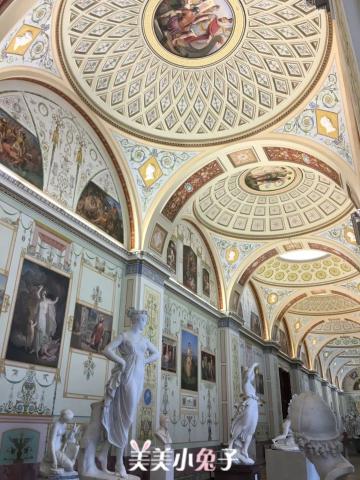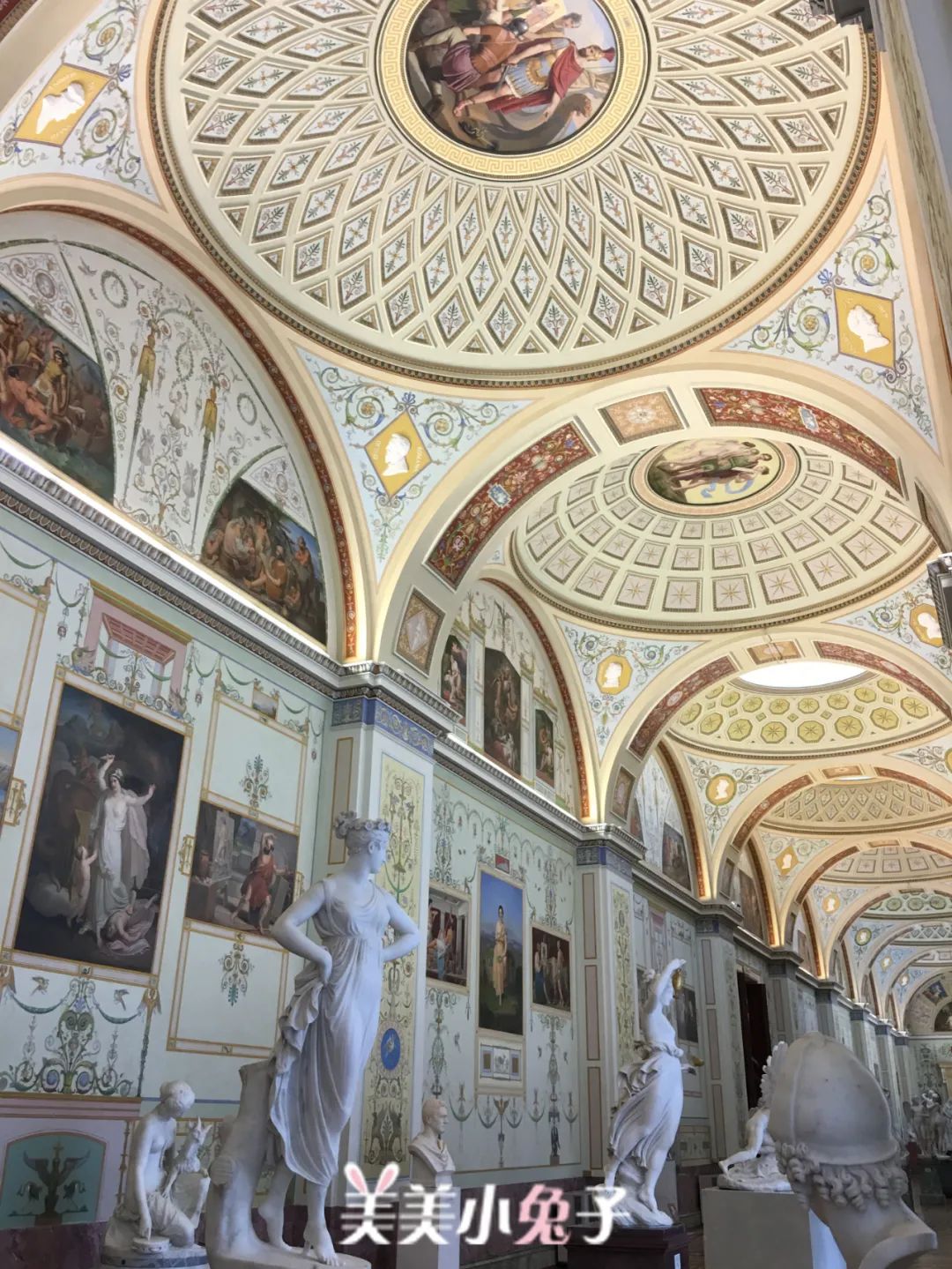

Pictured: Corridor of Ancient History Paintings in the Hermitage
Lao Wang said he could buy a piece of bread and carry a jug of water to stay in the Winter Palace all day.
St. Petersburg is the cultural capital of Russia, with a strong historical charm flowing everywhere.
Two of the three most famous palaces in St. Petersburg: the Summer Palace and the Winter Palace. As their names suggest, they were the places where the Russian emperors spent their summers and winters. The Russian summer was short, and the Tsar lived most of his time in the Winter Palace. The Summer Palace and the Winter Palace feel like the Versailles Palace and the Louvre in France. One reflects the Tsar's daily life, such as work, life, dances, and socializing; the other serves as a museum to display the Tsar's various treasures.
Compared with the roughness and simplicity of the Kalominskoya Manor, the Summer Palace should be called the Russian Summer Palace. In addition to the Grand Palace, the Summer Palace also has an Upper Garden and the most exquisite Lower Garden. The fountain in the garden has a lifelike shape, with the highest water spray reaching 22 meters. It does not rely on any external power and relies entirely on natural water pressure generated by the top-down topography. The Summer Palace is also famous for its exquisite fountains and unique water conservancy technology, and is known as the "Kingdom of Fountains". It is said that Peter the Great came here to spend summers every year, and he and his wife Catherine I lived in one of the most luxurious two-story palaces.

One of the top five museums in the world, the extremely luxurious Hermitage has witnessed the development of the great city of St. Petersburg and many important moments in Russian history.
In the February Revolution of 1917, the last Russian Emperor Nicholas II was forced to abdicate, and the Winter Palace ended its history as a tsarist palace. In the same year, the October Revolution sounded, and the Bolsheviks stormed into the Winter Palace to seize power, and a new world, not necessarily a better one, was established. In 1918, the capital of Soviet Russia was moved to Moscow, and St. Petersburg ended its two-century history as the tsarist capital.
Wander in this beautiful palace and admire its gorgeous, exquisite or simple individual indivual It is extremely satisfying to listen to the introduction of history, paintings, sculptures, etc.

Summer Palace of Peter the Great
In 1704, to commemorate his victory in the Northern War against Sweden, Russian Tsar Peter the Great ordered the construction of a summer palace. The summer palace is located 30 kilometers away from St. Petersburg, in the forest on the southern shore of the Gulf of Finland. It was the suburban summer residence of the tsars of the Romanov dynasty.
In the morning we walked 5,600 meters from the hotel to the pier next to the Winter Palace and took a speedboat there. The garden of the summer palace is large and beautiful, and the fountains in it are of different shapes. The Grand Palace is extremely gorgeously decorated, with golden luxury everywhere. There are celebration halls in the palace. This luxurious palace is also known as the "Russian Versailles".
The beautiful scenery makes people forget to leave, but it is a pity that people have set up camp at the gate to prepare for activities, which greatly destroys the beauty.
Address: Razvodnaya St., 2, Peterhof, St. Petersburg 198516, Russia

The State Hermitage Museum
The Winter Palace was originally the royal palace of the Tsars of the Russian Empire. After the October Revolution, it became part of the State Hermitage Museum in St. Petersburg. There are a total of 400 exhibition halls in the Hermitage. It is impossible to visit them all in one day. There is a Russian aunt in each hall. You can ask them for a guidebook inside the Hermitage, which contains the location of the exhibition halls and an introduction to the main collections.
There are Egyptian Hall, Ancient Greek and Roman Hall, etc. on the first floor. We saw mummies and ancient Greek sculptures here.
The second floor is the essence of the Winter Palace. It is best to read the guide book before visiting, otherwise it is easy to miss the treasure of the palace. We passed the Golden Hall, White Hall, Malachite Hall...
The third floor collects Far Eastern art, including works from China, Japan, Iran and other countries.
Tips: It is recommended that the tour time be allocated as 20% on the first floor, 70% on the second floor, and 10% on the third floor.
Address: Palace Emb., 30-38, St. Petersburg 191055, Russia
There is an oil painting of Peter the Great and Glory in the middle of the Peter Hall.


See below for details.
Summer Palace of Peter the Great
The Grand Palace's cascade waterfall, which consists of 64 fountains and multiple gold and bronze statues, is the most famous of all fountains and is called the "Grand Falls" fountain.

The upper garden is relatively ordinary, with neatly trimmed trees, several small pools and sculptures.

The most famous grand palace is between the Upper Garden and the Lower Garden.

Wear something autumnal.

A waterway serves as the central axis, leading directly to the coast of the Gulf of Finland, dividing the summer palace garden into two halves.

Looking from high to far, the field of vision is wider.

The lower garden is very large, and you can take a tour bus around the garden.







The pier is next to the lower garden, and we took the speedboat back and forth.



The State Hermitage Museum
The collection of the Hermitage is so rich, not only a large number of oil paintings and artworks from Western Europe, but also mummies from Egypt, Chinese oracle bones, Dunhuang murals and sculptures, etc.
The Alexander I Column is erected on the Winter Palace Square, built to commemorate the victory over Napoleon.

Enter via the ornate Jordan Staircase.

ceiling

egyptian room

In the gallery commemorating the 1812 War that defeated Napoleon, Lao Wang and Alexander I took a group photo.

St. George's Hall is the heart of the Winter Palace, where the coronation of the throne and many formal royal celebrations are held. There is the Tsar's throne in the center. It witnessed the convening of the Duma and the beginning of the disintegration of the Russian monarchy.

One of the most special features of the Winter Palace is its floor. Some patterns are made of twelve kinds of wood, and the floor and ceiling patterns correspond one to one.



The Malachite Hall is one of the most gorgeous and exquisite halls in the Winter Palace. This white and gold hall combines Renaissance, Gothic and Oriental style design and decoration. 28 crystal chandeliers make this hall shine. .

The famous Peacock Clock was made by the British clockmaker James Cox and was bought by Potemkin (the lover of Catherine II) as a gift to his sweetheart Catherine the Great. The peacock is the national bird of Russia and the birch is their national tree. This golden peacock with gold paste and the head of the rooster at its feet can move, and the peacock can also spread its wings. It is one of the treasures of the Winter Palace.

The Italian Skylight Hall contains many large Italian oil paintings from the 16th to 18th centuries. The ceiling is intentionally raised and a transparent skylight is used to let in natural light, making the hall brighter.

The ancient history painting corridor contains 86 oil paintings and many precious marble sculptures from the budding period of ancient Greek and Roman art. The famous "Three Graces" and "Angel's Kiss" are displayed in this hall.

The Sneiders Hall is an exhibition hall of Russian 17th-century works. It is named after the works of the famous still life painter Sneiders.



The Alexander Hall is dominated by blue and white, and combines Gothic style with classical art, making it look very light. The room was built in memory of Alexander I and is now used to display Western European silverware from the 17th to 18th centuries.
It looks like the palace of the Snow Queen.


The white hall is mainly white, with two-story bright windows and white tones that complement each other.


There are two golden drawing rooms in the Winter Palace: this is the Golden Room of Queen Alexander, and the other is the Golden Room of Queen Mary. The walls, doors, windows, chandeliers, roofs and furniture patterns of these two halls are all decorated with thick gold plating, giving people the impression of splendor and splendor. Gold was expensive in the eyes of the common people, but in the eyes of the extravagant and lustful emperors, it was nothing.


Queen Mary's Golden Room. As soon as I entered the exhibition hall, I was shocked. The walls and furniture were covered with large areas of red velvet and decorated with gold patterns. It was extremely luxurious.




Other exhibition halls





The grandeur inside the palace contrasts sharply with the rustic mint green walls outside.

